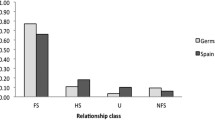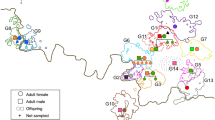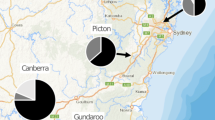Abstract
Social monogamy, considered rare in mammals, has been described in two species of beaver, the Eurasion beaver (Castor fiber), and the North American beaver (Castor Canadensis). Social monogamy, however, does not necessarily imply genetic monogamy. For example, in group living mammals, females may engage in extra-pair copulations as a result of increased female mate choice opportunities. Recently, following genetic analysis, a wide range of genetic relationships among colony members have been documented in the North American beaver, including extra-pair paternity. Here, we used microsatellite loci to provide parentage estimates from colonies of the Eurasian beaver in the Kirov region, Russia. No evidence for the presence of any extra-pair young was detected. However, in two cases, we found a pair of unrelated males inhabiting a single colony. Our results suggest that while colonies may comprise both related and unrelated individuals, the genetic mating system appears to match that of the previously inferred social monogamy.

Similar content being viewed by others
References
Babik W, Durka W, Radwan J (2005) Sequence diversity of the MHC DRB gene in the Eurasian beaver (Castor fiber). Mol Ecol 14:4249–4257
Baker BW, Hill EP (2003) Beaver (Castor canadensis). In: Feldhamer GA, Thompson BC, Chapman JA (eds) Wild Mammals of North America: Biology, Management, and Conservation, 2nd edn. The Johns Hopkins University Press, Baltimore, pp 288–310
Bierla JB, Gizejewski Z, Leigh CM, Ekwall H, Söderquist L, Rodriguez-Martinez H, Zalewski K, Breed WG (2007) Sperm morphology of the Eurasian beaver, Castor fiber: An example of a species of rodent with highly derived and pleiomorphic sperm populations. J Morphol 268:683–689
Brotherton PNM, Pemberton JM, Komers PE, Malarky G (1997) Genetic and behavioural evidence of monogamy in a mammal, Kirk's dik-dik (Madoqua kirkii). Proc R Soc Lond B 264:675–681
Bryja J, Patzenhauerová H, Albrecht T, Mošanský L, Stanko M, Stopka P (2008) Varying levels of female promiscuity in four Apodemus mice species. Behav Ecol Sociobiol 63:251–260
Busher PE, Warner RJ, Jenkins SH (1983) Population-density, colony composition, and local movements in two Sierra Nevadan beaver populations. J Mammal 64:314–318
Campbell RD, Rosell F, Nolet BA, Dijkstra VAA (2005) Territory and group sizes in Eurasian beavers (Castor fiber): echoes of colony and reproduction? Behav Ecol Sociobiol 58:597–607
Clutton-Brock TH, Isvaran K (2006) Paternity loss in contrasting mammalian societies. Biol Lett 2:513–516
Cohas A, Allainé D (2009) Social structure influences extra-pair paternity in socially monogamous mammals. Biol Lett 5:313–316
Crawford J, Liu Z, Nelson T, Nielsen C, Bloomquist C (2008a) Isolation and characterization of microsatellite loci in the beaver (Castor canadensis). Mol Ecol Res 8:616–618
Crawford JC, Liu Z, Nelson TA, Nielsen CK, Bloomquist CK (2008b) Microsatellite analysis of mating and kinship in beavers (Castor canadensis). J Mammal 89:575–581
Dakin EE, Avise JC (2004) Microsatellite null alleles in parentage analysis. Heredity 93:504–509
Ducroz JF, Stubbe M, Saveljev AP, Heidecke D, Samjaa R, Ulevicius A, Stubbe A, Durka W (2005) Genetic variation and population structure of the Eurasian beaver Castor fiber in Eastern Europe and Asia. J Mammal 86(6):1059–1067
Durka W, Babik W, Ducroz JF, Heidecke D, Rosell F, Samjaa R, Saveljev AP, Stubbe A, Ulevicius A, Stubbe M (2005) Mitochondrial phylogeography of the Eurasian beaver Castor fiber L. Mol Ecol 14:3843–3856
Ellegren H, Hartman G, Johansson M, Anderson L (1993) Major histocompatibility complex monomorphism and low levels of DNA fingerprinting variability in a reintroduced and rapidly expanding population of beavers. Proc Natl Acad Sci U S A 90(17):8150–8153
Fischer JW, Joos RE, Neubaum MA, Taylor JD, Bergman DL, Nolte DL, Piaggio AJ (2010) Lactating North American beavers (Castor canadensis) sharing dens in the southwestern United States. Southwest Nat 55(2):273–277
Frosch C, Haase P, Nowak C (2011) First set of microsatellite markers for genetic characterization of the Eurasian beaver (Castor fiber) based on tissue and hair samples. Eur J Wildl Res 57:679–682
Frosch C, Kraus RHS, Angst C, Allgower R, Michaux J, Teubner J, Nowak C (2014) The genetic legacy of multiple beaver reintroductions in central Europe. PLoS ONE 9:e97619
Gohli J, Anmarkrud JA, Johnsen A, Kleven O, Borge T, Lifjeld JT (2013) Female promiscuity is positively associated with neutral and selected genetic diversity in passerine birds. Evolution 67:1406–1419
Hardy OJ, Vekemans X (2002) SPAGeDi: a versatile computer program to analyse spatial genetic structure at the individual or population levels. Mol Ecol Notes 2:618–620
Hartman G (1997) Notes on age at dispersal of beaver (Castor fiber) in an expanding population. Can J Zool 75:959–962
Hayes LD (2000) To nest communally or not to nest communally: a review of rodent communal nesting and nursing. Anim Behav 59:677–688
Hennessy CA, Dubach J, Gehrt SD (2012) Long-term pair bonding and genetic evidence for monogamy among urban coyotes (Canis latrans). J Mammal 93:732–742
Herr J, Rosell F (2004) Use of space and movement patterns in monogamous adult Eurasian beavers (Castor fiber). J Zool 262(3):257–264
Hinze G (1960) Unser Biber. Die Neue Brehm-Bücherei; Heft 111. Verlagsgesellschaft Geest & Portig, Leipzig
Horn S, Durka W, Wolf R, Ermala A, Stubbe A, Stubbe M, Hofreiter M (2011) Mitochondrial genomes reveal slow rates of molecular evolution and the timing of speciation in beavers (Castor), one of the largest rodent species. PLoS ONE 6:e14622
Huck M, Fernandez-Duque E, Babb P, Schurr T (2014) Correlates of genetic monogamy in socially monogamous mammals: insights from Azara's owl monkeys. Proc R Soc Lond B 281:20140195
Jennions MD, Petrie M (2000) Why do females mate multiply? A review of the genetic benefits. Biol Rev 75:21–64
Jones O, Wang J (2010) COLONY: a program for parentage and sibship inference from multilocus genotype data. Mol Ecol Res 10:551–555
Jones AG, Small CM, Paczolt KA, Ratterman NL (2010) A practical guide to methods of parentage analysis. Mol Ecol Res 10:6–30
Kalinowski ST, Taper ML, Marshall TC (2007) Revising how the computer program CERVUS accommodates genotyping error increases success in paternity assignment. Mol Ecol 16:1099–1106
Kenagy GJ, Trombulak SC (1986) Size and function of mammalian testes in relation to body size. J Mammal 67:1–22
Kleiman DG (1977) Monogamy in mammals. Q Rev Biol 52:39–69
Konovalov DA, Manning C, Henshaw MT (2004) KINGROUP: a program for pedigree relationship reconstruction and kin group assignments using genetic markers. Mol Ecol Notes 4:779–782
Lardy S, Cohas A, Desouhant E, Tafani M, Allainé D (2012) Paternity and dominance loss in male breeders: The cost of helpers in a cooperatively breeding mammal. PLoS ONE 7:e29508
Lavrov LS (1960) Comments on biological and morphological distinction of European and Canadian beavers (K voprosu o biologicheskih i morphologicheskih razlichijah mezhdu evropeiskimi i kanadskimi bobrami). Proc. Voronezh State Zapovednik 11:103–120 [In Russian]
Lavrov VL (1989) On the possibility of the polygamic breeding of the beavers in captivity (O vozmozhnosti poligamnogo razvedenia bobrov v uslovijah kletochnogo soderzhania). Byulleten’ Mosk Obs Ispyt Prir Otd Biol 94:41–43 [in Russian with Engl summary]
Lott DF (1984) Intraspecific variation in the social systems of wild vertebrates. Behaviour 88:266–325
Lukas D, Clutton-Brock T (2012) Cooperative breeding and monogamy in mammalian societies. Proc R Soc Lond B 279:2151–2156
Marshall TC, Slate J, Kruuk LEB, Pemberton JM (1998) Statistical confidence for likelihood-based paternity inference in natural populations. Mol Ecol 7:639–655
Milishnikov AN, Saveljev AP (2001) Genetic divergence and similarity of introduced populations of European beaver (Castor fiber L., 1758) from Kirov and Novosibirsk oblasts of Russia. Russ J Genet 37:108–111
Møller AP, Garamszegi LZ, Spottiswoode CN (2008) Genetic similarity, breeding distribution range and sexual selection. J Evol Biol 21:213–225
Müller-Schwarze D (2011) The beaver: Its life and impact, 2nd edn. Cornell University Press, Ithaca
Nitsche KA (2001) Behaviour of beavers (Castor fiber albicus Matschie, 1907) during the flood periods. In: Czech A, Schwab G (eds) Proceedings of 2nd European Beaver Symposium. Carpathian Heritage Society, Krakow, pp 51–53
Packer C, Pusey AE (1982) Cooperation and competition within coalitions of male lions – kin selection or game-theory. Nature 296:740–742
Patenaude F (1983) Care of the young in a family of wild beavers, Castor canadensis. Acta Zool Fenn 174:121–122
Pelz-Serrano K, Munguia-Vega A, Piaggio AJ, Neubaum M, Munclinger P, Partl A, Van Riper C, Culver M (2009) Development of nine new microsatellite loci for the American beaver, Castor canadensis (Rodentia: Castoridae), and cross-species amplification in the European beaver, Castor fiber. Mol Ecol Res 9:551–554
Petrie M, Lipsitch M (1994) Avian polygyny is most likely in populations with high variability in heritable male fitness. Proc R Soc Lond B 256:275–280
Petrie M, Doums C, Møller AP (1998) The degree of extra-pair paternity increases with genetic variability. Proc Natl Acad Sci U S A 95:9390–9395
Queller DC, Goodnight KF (1989) Estimating relatedness using genetic-markers. Evolution 43:258–275
Ribble DO (1991) The monogamous mating system of Peromyscus californicus as revealed by DNA fingerprinting. Behav Ecol Sociobiol 29:161–166
Rosell F, Bjørkøyli T (2002) A test of the dear enemy phenomenon in the Eurasian beaver. Anim Behav 63:1073–1078
Rosell F, Thomsen LR (2006) Sexual dimorphism in territorial scent marking by adult Eurasian beavers (Castor fiber). J Chem Ecol 32:1301–1315
Rosell F, Johansen G, Parker H (2000) Eurasian beavers (Castor fiber) behavioral response to simulated territorial intruders. Can J Zool 78:931–935
Safonov VG (1965) Some features of ecology of the beaver during the winter period (Nekotorye osobennosti ekologii rechnogo bobra v zimnij period). Bull Sci and Techn Inf “Hunting-Fur-Game”. Kirov 12:26–35 [In Russian]
Safonov VG (1971) Notes on biology of beaver reproduction in the European part of the USSR (Materialy po biologii razmnozhenia rechnyh bobrov v Evropejskoj chasti SSSR). Questions of biology of game animals and the organisation of the hunting husbandry. Proc Kirov Argic Inst 28:25–39 [In Russian]
Saveljev AP (2001) Rettung des Bibers (Castor fiber) in Russland: offensichtlicher jagdwirtschaftlicher Erfolg mit zoologischen Problemen nach 70 Jahren. Beitr Jagd-Wildforsch 26:309–315
Saveljev A, Milishnikov A (2002) Biological and genetic peculiarities of cross-composed and aboriginal beaver populations in Russia. Acta Zool Lit 12:397–402
Saveljev AP, Stubbe M, Stubbe A, Putintsev NI, Oleynikov AY, Savelyev AA (2010) Movements of beavers under natural conditions and in places of introduction (Peremeshenia bobrov v estestvennoi obstanovke i v mestah introdukcii). Vestnik Ochotovedenia (Game Sci Bull) 7:340–344 [In Russian with English summary]
Senn H, Ogden R, Cezard T, Gharbi K, Iqbal Z, Johnson E, Kamps-Hughes N, Rosell F, Mcewing R (2013) Reference-free SNP discovery for the Eurasian beaver from restriction site-associated DNA paired-end data. Mol Ecol 22:3141–3150
Senn H, Ogden R, Frosch C, Syruckova A, Campbell-Palmer R, Munclinger P, Durka W, Kraus RHS, Saveljev AP, Nowak C, Stubbe A, Stubbe M, Michaux J, Lavrov V, Samiya R, Ulevicius A, Rosell F (2014) Nuclear and mitochondrial genetic structure in the Eurasian beaver (Castor fiber) – implications for future reintroductions. Evol Appl 7:645–662
Sommer S, Tichy H (1999) Major histocompatibility complex (MHC) class II polymorphism and paternity in the monogamous Hypogeomys antimena, the endangered, largest endemic Malagasy rodent. Mol Ecol 8:1259–1272
Soulsbury CD (2010) Genetic patterns of paternity and testes size in mammals. PLoS ONE 5:e9581
Stubbe A, Stubbe M, Saveljev AP, Unžakov VV (2003) Der Lebendfang als Grundlage für Wachstumsanalysen und die Morphometrie von Körpermassen in autochthonen Biberpopulationen. In Stubbe M, Stubbe A (eds) Methoden feldökologischer Säugetierforschung 2. Martin-Luther-Universität Halle-Wittenberg, pp 329-347
Sun L (2003) Monogamy correlates, socioecological factors, and mating systems in beavers. In: Reichard UH, Boesch C (eds) Monogamy: Mating Strategies and Partnerships in Birds. Humans and Other Mammals. Cambridge university press, Cambridge, pp 138–146
Svendsen GE (1980) Patterns of scent-mounding in a population of beaver (Castor canadensis). J Chem Ecol 6:133–148
Tinnesand HV, Jojola S, Zedrosser A, Rosell F (2013) The smell of desperadoes? Beavers distinguish between dominant and subordinate intruders. Behav Ecol Sociobiol 67:895–904
van Oosterhout C, Hutchinson B, Wills D, Shipley P (2004) MICRO-CHECKER: software for identifying and correcting genotyping errors in microsatellite data. Mol Ecol Notes 4:535–538
Wheatley M (1993) Report of two pregnant beavers, Castor canadensis, at one beaver lodge. Can Field Nat 107:103
Wilsson L (1971) Observations and experiments on the ethology of the European beaver (Castor fiber L.). Viltrevy 8:115–266
Acknowledgments
We highly appreciate the help of hunters from the Kotelnich regional hunter union. CF is particularly grateful for the assistance given by C Nowak and RHS Kraus. AS was supported by the Charles University in Prague (projects GAUK 151210 and SVV 260 087/2014). PM and AS thank Z Csiebreiová for her technical assistance in the laboratory. We are also grateful to T Albrecht and three anonymous reviewers for insightful comments on the previous version of the manuscript.
Ethical standards
Research followed Russian federal hunting law (2009 N 209).
Author information
Authors and Affiliations
Corresponding author
Additional information
Communicated by: Mabel D. Giménez
Rights and permissions
About this article
Cite this article
Syrůčková, A., Saveljev, A.P., Frosch, C. et al. Genetic relationships within colonies suggest genetic monogamy in the Eurasian beaver (Castor fiber). Mamm Res 60, 139–147 (2015). https://doi.org/10.1007/s13364-015-0219-z
Received:
Accepted:
Published:
Issue Date:
DOI: https://doi.org/10.1007/s13364-015-0219-z




